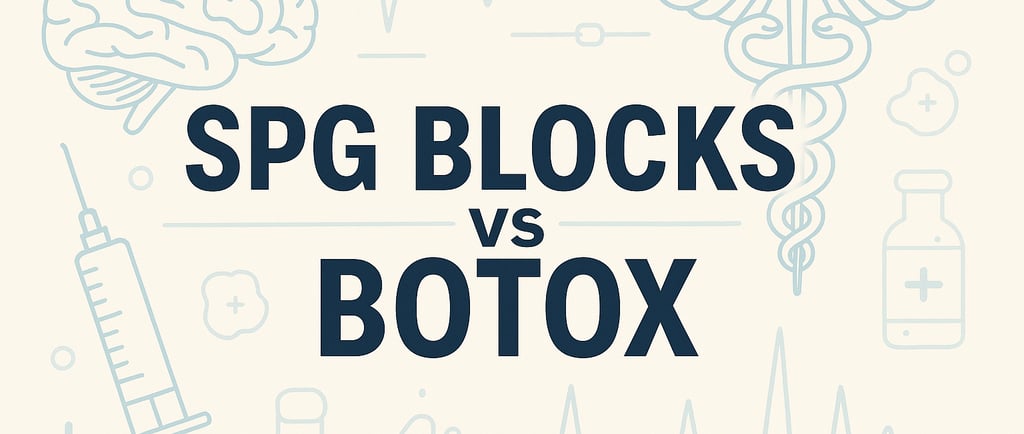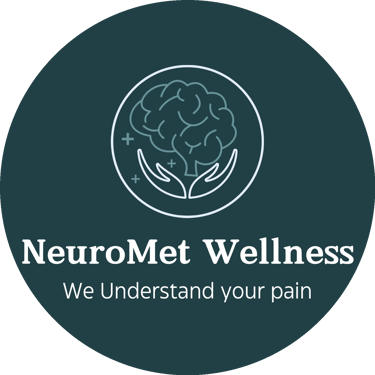SPG Blocks vs. Botox: A Comparative Guide to Chronic Headache Management
Discover two innovative options for tackling chronic headaches—Sphenopalatine Ganglion (SPG) blocks and Botox injections. In this concise guide, we break down how each treatment works, what current evidence shows about their short- and long-term benefits, and what you need to know about cost, side effects, and ease of administration. Whether you’re a clinician seeking new approaches or a patient exploring relief, this post gives you the essential insights to make an informed choice.
HEADACHES
Dr. Bhupesh Kumar
6/3/20255 min read


Introduction
Chronic headaches can significantly impair quality of life and impose substantial personal, financial, and societal burdens. Globally, migraine ranks among the top 20 causes of disability and accounts for 1.3% of life-years lost to disability. Because these conditions are notoriously challenging to manage, clinicians and patients alike often explore treatments beyond standard pharmacotherapy. Two such options are Sphenopalatine Ganglion (SPG) blocks and Botox injections. In this post, we compare their mechanisms, efficacy, cost considerations, and other factors relevant to chronic headache care.
1. Understanding the Sphenopalatine Ganglion (SPG) Block
The sphenopalatine ganglion (SPG)—also called the pterygopalatine or Meckel’s ganglion—is a dense cluster of nerve cells situated deep within the face, behind the nasal bones in the pterygopalatine fossa. It’s the largest neural ganglion in the calvarium outside the brain and can be accessed via the nasal mucosa. Because the SPG connects directly to the trigeminal nerve (the main pain pathway in most headaches), it plays a critical role in migraine and cluster headache pathophysiology. The SPG contains both sensory fibers (for pain perception) and autonomic fibers (regulating tearing and nasal congestion). It’s also a key node in the trigeminal-autonomic reflex, which drives cranial vasodilation and neurogenic inflammation during headache attacks.
1.1 How SPG Blocks Work
An SPG block interrupts nociceptive (pain) signals and modulates autonomic outflow by applying a local anesthetic directly to the ganglion. By blocking sensory fibers, it may reduce pain perception; by dampening parasympathetic activity, it inhibits perivascular pain receptors and limits neuroinflammatory mediator release. In short, an SPG block aims to “break” the trigeminal-autonomic reflex loop that perpetuates many headache syndromes.
1.2 Administration Methods
Transnasal (cotton-tipped applicator or catheter): Historically, clinicians soaked cotton swabs in local anesthetic, inserted them into the nasal cavity, and held them against the SPG for a few minutes. Today, specialized catheters (e.g., SpenoCath®, Allevio™, Tx360™) are more common and allow drug delivery with better patient comfort and accuracy.
Infrazygomatic (lateral infratemporal) approach: This “needle” technique requires fluoroscopic or ultrasound guidance to deposit anesthetic precisely.
Transoral approach: Less common but occasionally used when nasal access is contraindicated.
Some patients, after proper instruction, can self-administer a simplified transnasal SPG block at home using a prefilled syringe or cotton applicator.
1.3 Indications
SPG blocks have been studied (with varying degrees of evidence) in:
Chronic migraine
Cluster headache
Trigeminal neuralgia
Post-dural puncture headache (PDPH)
Persistent idiopathic facial pain
Herpes zoster ophthalmicus pain
Other facial neuralgias
Temporomandibular joint (TMJ) pain
Head and neck cancer pain
1.4 Side Effects and Safety
Side effects are generally mild and self-limited, resolving within minutes to hours. Common adverse effects include:
Transient oropharyngeal numbness
Bitter taste (from anesthetic dripping into throat)
Lightheadedness or brief hypotension
Lacrimation (tearing)
Nasal irritation or minor epistaxis
Temporary dysphagia (difficulty swallowing)
Serious complications (seizure, infection, severe allergic reaction) are exceedingly rare when performed correctly.
2. Understanding Botox for Chronic Migraine
OnabotulinumtoxinA (Botox®) was FDA-approved in 2010 for chronic migraine prevention in adults experiencing ≥15 headache days per month. It’s now a staple prophylactic intervention for patients who have failed—or are intolerant to—traditional oral preventives.
2.1 How Botox Works
Botox inhibits the release of neurotransmitters such as CGRP (Calcitonin Gene-Related Peptide), substance P, and glutamate from peripheral trigeminal nociceptive neurons. It also disrupts TRP (transient receptor potential) channels, reducing neuronal hyperexcitability. By doing so, Botox attenuates both peripheral and central sensitization—key processes driving chronic migraine.
2.2 Administration
Qualified injectors: Neurologists, headache specialists, plastic surgeons, and trained pain physicians.
Injection sites: Multiple standardized sites around the head and neck (typically 31 injections totaling 155 units).
Onset: Patients may not see benefit until 4–6 weeks after the first session. Multiple quarterly treatments (every 12 weeks) are often required to achieve and maintain optimal response.
2.3 Benefits
Significant reduction in headache days (PREEMPT clinical program).
Lower attack severity and easier acute treatment.
Decreased dependence on acute rescue medications.
Improvement in disability scores and overall quality of life.
Reduction in associated neck pain.
2.4 Safety Considerations
Generally safe and well tolerated.
Side effects tend to be mild (e.g., neck pain, slight muscle weakness at injection site, transient injection-site discomfort).
Pregnancy safety: Not well studied—pregnant or planning pregnancy should discuss risks/benefits with their provider.
3. SPG Block vs. Botox: A Head-to-Head Comparison
While both SPG blocks and Botox injections are used in chronic migraine management, they differ substantially in mechanism, invasiveness, evidence base, and cost.
3.1 Efficacy
SPG Blocks (Chronic Migraine):
Short-term relief: RCTs have shown significantly greater pain reduction up to 24 hours post-block vs. placebo. Many patients report near-immediate relief (2–3 minutes), full effect by 15 minutes.
Preventive (long-term) data: Mixed. One RCT found no significant difference at 1 and 6 months after 12 blocks (underpowered study). Conversely, open-label series and smaller trials suggest that repetitive SPG blocks may reduce monthly headache days, severity, and convert chronic migraine to episodic migraine in ~72.5% of responders over a nine-month follow-up. Robust, long-term RCTs are still lacking.
Botox (Chronic Migraine):
Evidence is strong: PREEMPT 1 & 2 trials (double-blind, randomized, placebo-controlled) confirmed significant reductions in mean headache days and Headache Impact Test (HIT-6) scores at 24 weeks. Benefits often become evident by the second injection cycle (week 24).
Direct Comparisons: No published head-to-head RCTs. A trial comparing GON (greater occipital nerve) blocks vs. SPG blocks in episodic migraine found GON blocks more effective; however, a true SPG vs. Botox trial is still ongoing.
3.2 Cost Considerations
SPG Blocks:
Widely described as a “simple, inexpensive procedure.”
In India, a single outpatient SPG block can cost approximately ₹5,000–₹7,000, depending on clinician experience and setting.
Repetitive blocks may add up, but each session remains relatively low-cost compared to onabotulinumtoxinA.
Botox Injections:
Exact figures vary by region, but Botox therapy for chronic migraine (including drug cost and injector fees) is substantially more expensive than a single SPG block.
Insurance coverage (where available) can mitigate out-of-pocket expense, but approval criteria often include failure of ≥2 prophylactic oral agents.
Many patients require treatments every 12 weeks indefinitely to maintain benefit.
3.3 Invasiveness & Patient Tolerance
SPG Blocks:
Transnasal approach: minimally invasive, quick (often <15 minutes), usually no needles (unless using infrazygomatic route).
Some patients find nasal administration uncomfortable (e.g., gag reflex, transient burning).
Self-administration is possible, which increases convenience.
Botox Injections:
Requires 31 precise intramuscular injections around the head/neck.
Some patients experience temporary neck/shoulder muscle weakness or soreness at injection sites.
Overall, well tolerated by most.
3.4 Duration & Frequency of Relief
SPG Blocks:
Acute relief: Rapid onset (minutes), but duration is variable—anywhere from days to weeks, occasionally months.
Repetition: Many regimens recommend blocks every 1–2 weeks initially, then taper depending on response.
There is no standardized protocol: frequency/duration remain clinician-dependent and patient-specific.
Botox Injections:
Prophylaxis timeline: Requires ~4–6 weeks to see initial effects.
Maintenance: Injections every 12 weeks are standard to sustain benefit.
Long-term: Some patients maintain benefit for years; others may lose response and need alternative strategies.
3.5 Other Considerations
Investigational Status:
Many insurers (e.g., Blue Cross Blue Shield of Massachusetts) still consider SPG blocks “investigational” for most headache indications, limiting coverage.
Botox is FDA-approved (in the U.S.) for chronic migraine, making it more widely accepted and reimbursed.
Clinician Experience:
SPG blocks: Heterogeneous practice patterns; many headache specialists lack formal training or clear protocols.
Botox: Standardized injection sites and dosing (PREEMPT protocol) mean more predictable techniques and outcomes.
Scope of Application:
SPG blocks extend beyond migraine: used in cluster headache, trigeminal neuralgia, PDPH, post-surgical facial pain, and oncologic pain.
Botox’s primary headache indication is chronic migraine; off-label uses for tension-type headache or cluster headaches exist but have weaker evidence.
Conclusion
Both SPG ganglion blocks and onabotulinumtoxinA injections offer viable strategies for chronic headache sufferers—particularly those with refractory chronic migraine.
SPG Blocks:
Pros: Low cost, minimal invasiveness, rapid onset of relief, potential applicability to a broad range of head and facial pain syndromes.
Cons: Inconsistent long-term data, lack of standardized protocols, variable insurance coverage.
Botox Injections:
Pros: Strong RCT support, FDA-approved for chronic migraine, consistent dosing/injection protocols, durable benefit across multiple cycles.
Cons: Higher cost, need for repeated injections every 12 weeks, slower onset (weeks), potential for injection-site discomfort.
No head-to-head RCT has yet established the superior approach. Decisions should be individualized—taking into account patient preference, prior treatment response, cost/coverage issues, and clinician expertise. Collaboration between patient and neurologist (or headache specialist) remains key to selecting the optimal therapy for each chronic headache phenotype.
Address:
Neuromet Wellness Clinic,
LG-02, Ansals Boom Plaza,
opp. HDFC School,
Sector-57, Gurgaon - 122003
Contact
Copyright © Dr. Bhupesh Kumar (Neurologist)
